So, dear readers, another newsletter hits the front page.
This week we have again been pressing on with the indexing, and have almost reached February 2022, but we were thwarted by a double of Wills First Aid Series. I do have a replacement card but will not fit it in tonight.
We also adjusted several cards, these being :
the addition of
-
Anonymous / Amalgamated Press "Football Fame Series" - https://csgb.co.uk/cardoftheday/2022-03-12
-
Clevedon "Famous Footballers" - https://csgb.co.uk/cardoftheday/2022-03-05
-
Imperial Tobacco of Canada "Fishes of the World" - https://csgb.co.uk/cardoftheday/2022-03-06
-
Panini "The Royal Family" - https://csgb.co.uk/cardoftheday/2022-03-24
plus :
a better biography of I Rutter & Co. - https://csgb.co.uk/cardoftheday/2022-03-16
To be added over the weekend will be a lot of information about Olleschau, maybe even a blog, and also some very interesting research and photographs of those Garbaty Tarso tiles.
But what of this week? Well we have a lost speedway, and too many lost movies - games old, and new - more than a glimpse of stocking - a baseball card that I have never seen before - and the story of the Hyde Park Hackneys.
Lets start with .....
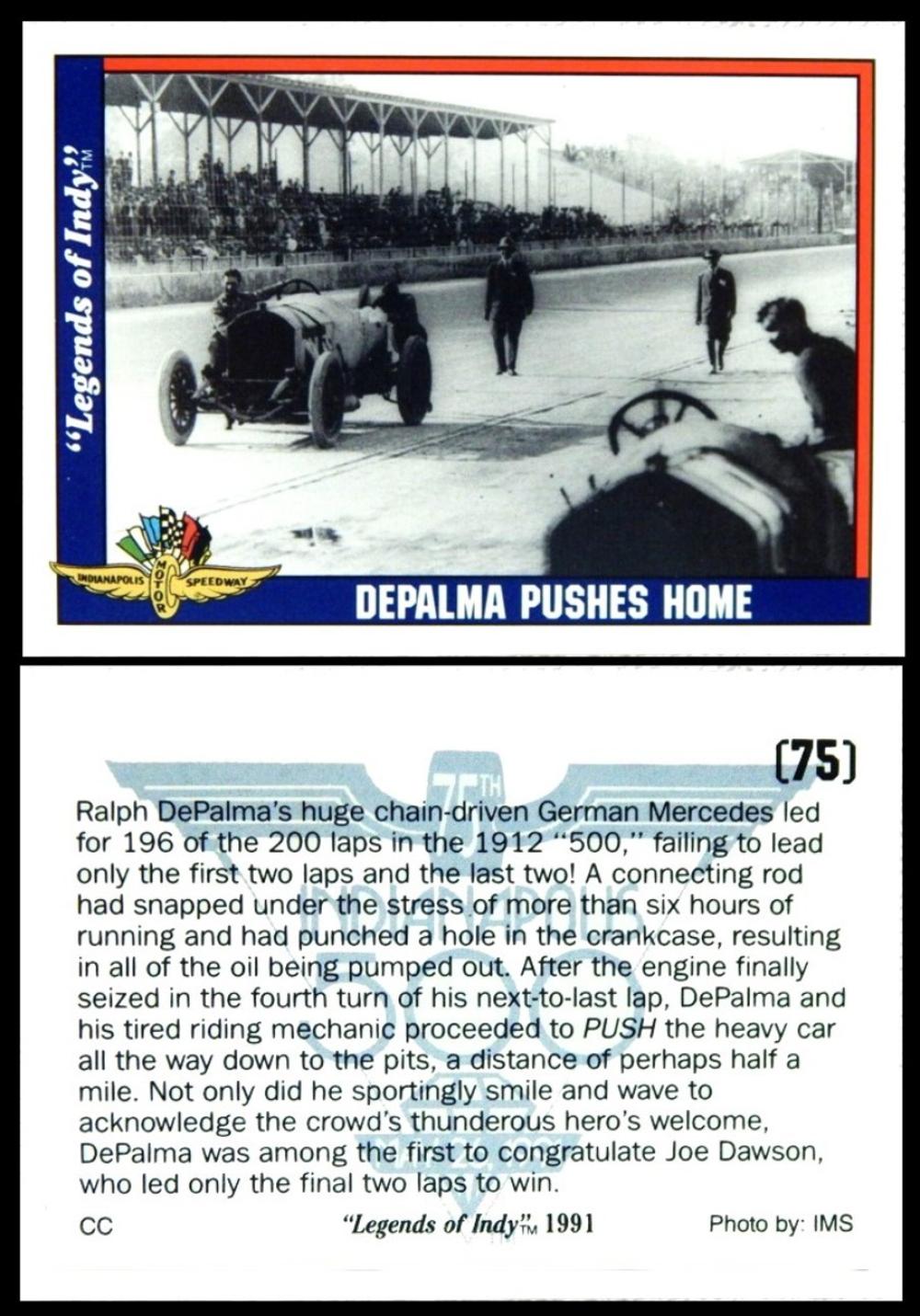
G.S.S. [trade/commercial : O/S : USA] “Legends of Indy” (1991) 75/100
Lets start with a centenary, a sad one in some ways, as it marks the final race at the Beverley Hills Speedway, also known as the Los Angeles Speedway.
Now this was not motorbikes, but cars. The wooden, mile and half long, banked track was built in 1918 and the first meeting was on February 28th 1920. There were not too many meetings, but it gained a place in the hearts of racegoers, until the site was seen as being more valuable in real estate terms than in fun and entertainment ones. And so the last race was held today in 1924.
Our card shows one of the stars of that speedway, Ralph dePalma, who had been born in Italy and christned Raffaele DePalma. This was earlier in his career than the Beverly Hills Speedway, for this was at Indianapolis in 1912, pushing his mighty car, when all the time fellow racer Joe Dawson was catching up steadily, and would eventually go past to win. However our man did pass the post, in eleventh. The race had been running for six hours at that point.
He would not actually win there until 1915. And in later life, right into the 1950s, he was a track man and referee. His family were also racers, his brother contemporary with him, and his nephew winning in 1925.
His first win at the Beverly Hills Speedway was on February 27th, 1921, and in that same year he competed in Le Mans, coming home second. This race can be seen on Mobil "The Story of Grand Prix Motor Racing" (1971) 6/36.
And if you are lucky you may find his rookie card, issued in 1911 American Tobacco, in a set called "Auto Drivers", which I have just found at the Trading Card Database/Ralph DePalma - and the listing shows that he also appears on another card in our series!
So there are two of our sets, celebrating the Indianapolis “Indy” 500 motor race. Ours was issued in 1991 and there is a second set issued the following year. We know that there were ten cards in a pack but they seem to be just cards, not gum. They are unusual cards because they not only show the stars that we all know, but dig deep into the story of the race. A special album was also issued. And if anyone knows any more info do tell us!
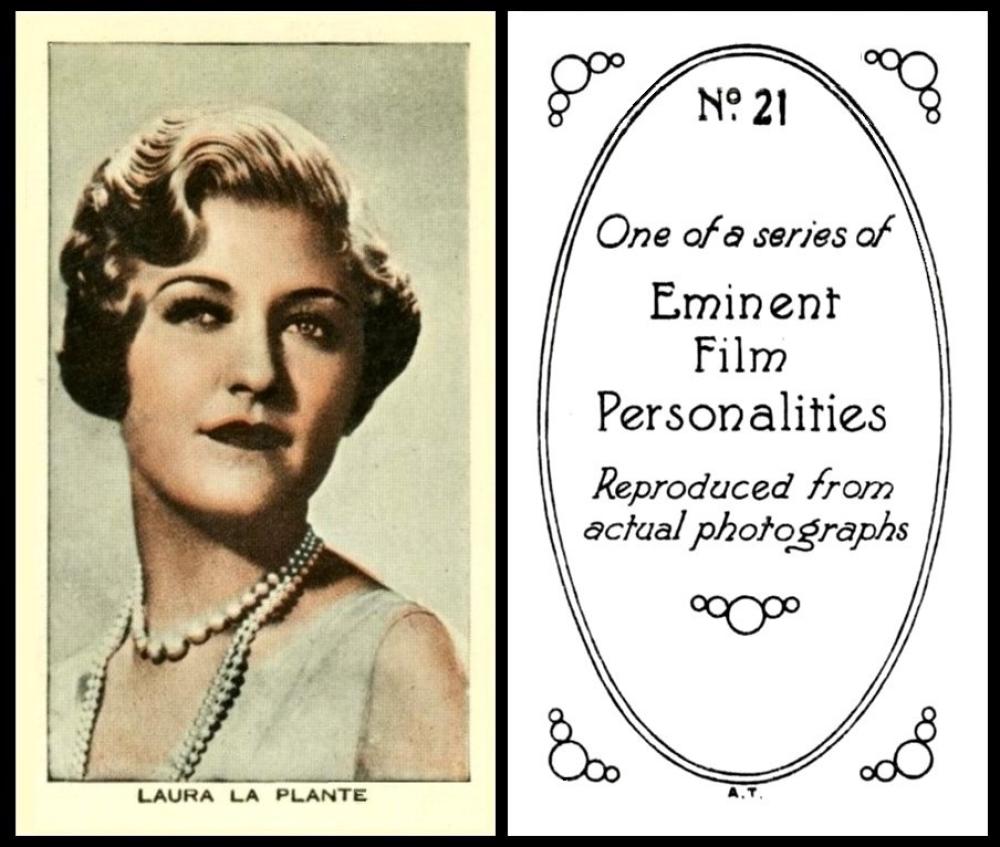
Anonymous / British American Tobacco [tobacco : O/S : South Africa] “Eminent Film Personalities” (1930) 21/50 – ZB07-240 : ZB6-18 : B/264 [RB.21/264]
Second centenary of the week in two days, and this celebrates a birth, the premiere of “Ride for Your Life”. The stars there were Hoot Gibson (who we have spoken about in a previous newsletter) and Laura la Plante, showing here.
Sadly the film is lost, it only survives because of lobby cards and contemporary references in magazines. It was a cowboy, rather a thin plot, [cow]boy meets girl, loses her to a bandit, and wins her back in rather odd circumstances by pretending to be the bandit, who was killed. However once she finds out, she does not seem to mind.
In fact many of her films are lost, including her first, in 1920, in which she was named in the cast list and had a character name too. This is almost certainly why she is not better known today. In her day, she was a great all rounder, who could sing and dance, and even appeared in the original version of “Show Boat”, though, for some reason, her voice was not used, and her part was dubbed in.
In 1923 she made eight films, only one of which survives. Her first card is stated to be Godfrey Phillips “Cinema Stars” issued in 1924 – that year she made seven films, three of which are lost. Problem is that this reverse mentions "Show Boat" which was not until 1929.
She retired in 1935. However she returned to films in the late 1940s and then retired again in 1957. She did not die until the age of 91, in 1996.
This card appears in our original British Americn Tobacco reference book (RB.21), issued in 1952, as :
264. EMINENT FILM PERSONALITIES. Small cards, size 69 x 39 m/m.
Front in light colour, glossy with yellowish tinge.Back per Fig.264. Anonymous issue with letterpress on back.
At the front of the book, in the index, it is described as :
Eminent Film Personalities (1930) – South Africa
In our World Tobacco Issues Indexes it appears at the back of the book, under anonymous issues – with letterpress on back – without reference to tobacco – and in section 2. “Overseas Issues Through B.A.T.” The header there gives the size too, “Small size 67-68 x 35-36 m/m unless stated.”
The listing for our set in both books reads :
EMINENT FILM PERSONALITIES. Sm. 68 x 39. Nd. (50). See RB.21/264. Issued in S. Africa
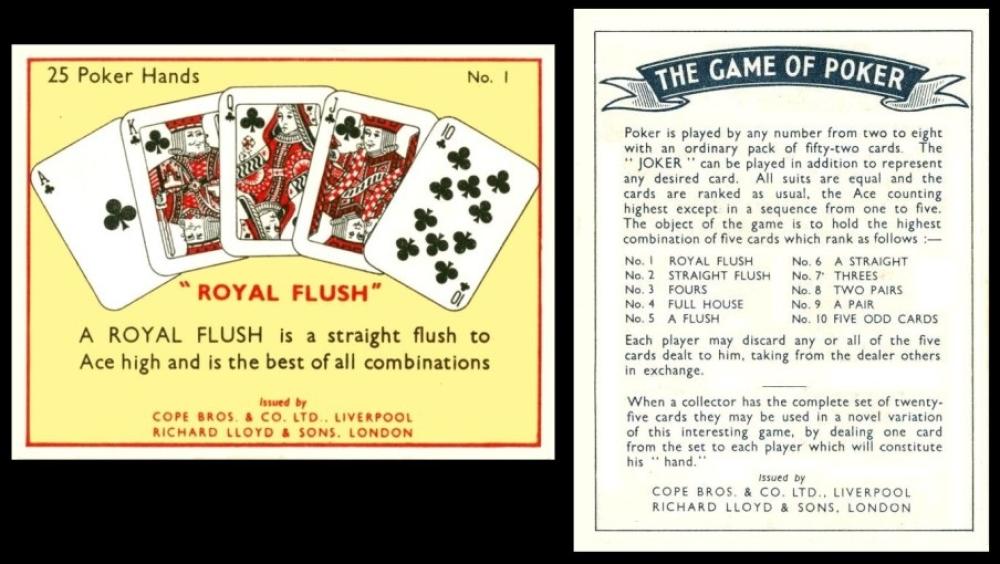
Cope Bros [tobacco : UK] “The Game of Poker” 1/25 – C798-750 : C132-83
Today, being “Play More Cards Day”, we have found this. The game of poker was a game that was indeed played in the Wild West, but this is almost certainly a more refined version, without the bar-room brawling and the shooting.
In our World Tobacco Issues Indexes this set is catalogued as :
THE GAME OF POKER. Md. 74 x 57. Nd. (25)
It is under C for Cope, in section 6, which covers the “Joint Cope-Richard Lloyd issues. Issued 1938-39. Inscribed with both Cope and Richard Lloyd names". The card actually says them too - Cope Bros. & Co. Ltd. Liverpool and Richard Lloyd & Sons, London.
Cope actually bought Richard Lloyd in 1902, and the proprietor of the time was given the job of managing Cope Bros. However in 1953 Cope was bought out by Gallaher, who, strangely, quickly got rid of all the Cope Brands and kept the Richard Lloyd ones, including the best known of all, ”Old Holborn”
The card also tells us that “when a collector has the complete set of twenty-five cards they may be used in a novel variation of this interesting game, by dealing one card from the set to each player which will constitute his “hand”. I wonder if any of our older readers ever remember doing that, or being told that even older collectors had?
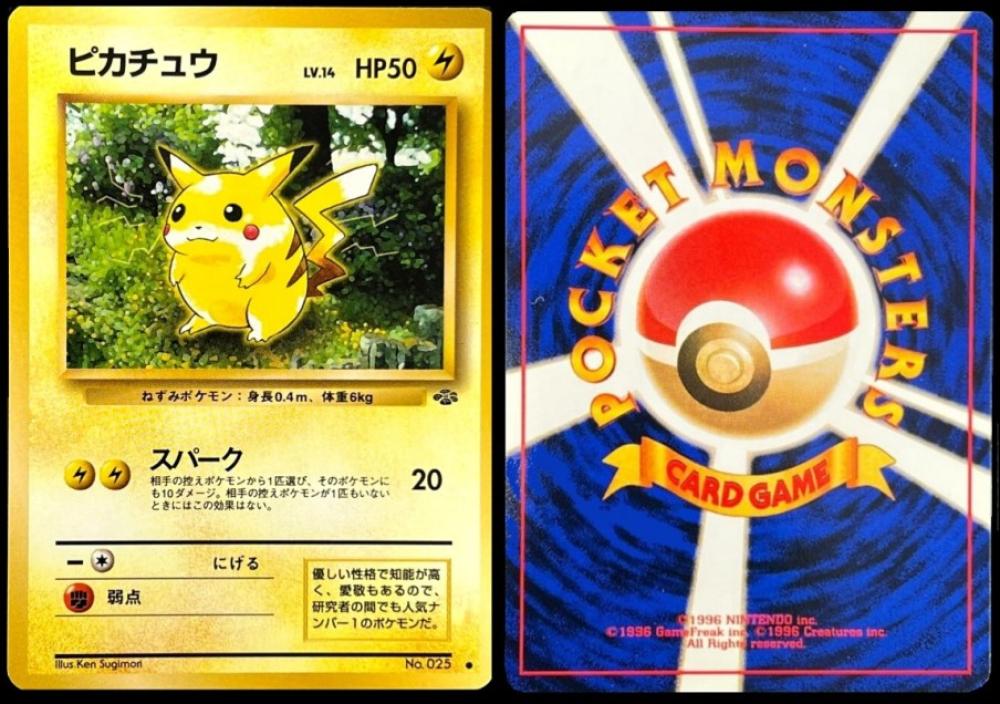
Nintendo [trade/commercial : O/S : Japan] “Pocket Monsters” (1996) 25/102
One for our younger audience, perhaps, but it may give you some street cred with your grandchildren (or great-grandchildren) if you mention that today is Pokemon Day.
The video games came first, you know, in February 1996, with the cards arriving in October, in a strange way, being circulated with a comic, called CoroCoro. These cards featured Pikachu (the mouse) and Jigglypuff (the balloon).
Here we have one of those first Pocket Monsters, the Pikachu, except you may not realise that because all the text, save the reverse, is in Japanese. This was a very canny marketing move, and leads to this set’s other name of “Japanese old-back,” because was the very first design used.
By the way there is an error on this card, the illustrator’s credit bottom left ought to say Keiji Kinebuchi, not Ken Sugimori.
Now in the same year the backs changed, and the best way to tell the two apart is that you can make out the swirls on our back but they are blurred on the next issue. Actually it is holographic foil, so if you tilt the card it does become clearer.
The back that we see here in England has the ball with the eye in the middle of a band, above which is red and below which white. The only word on the reverse of those is Pokemon, an abbreviation of Pocket Monsters, and this appears facing both ways on the upper and lower edges of the back.
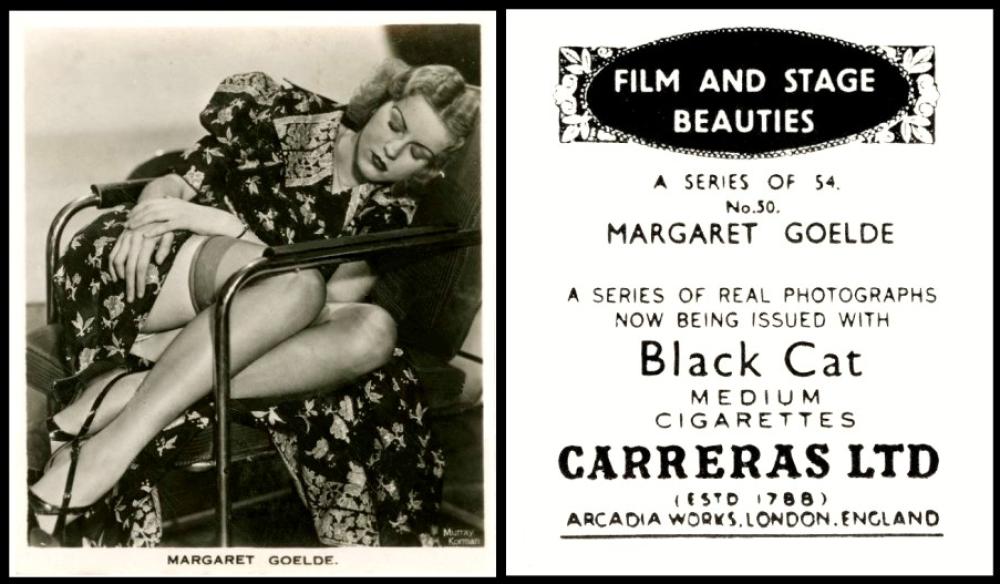
Carreras Ltd. [tobacco : UK] “Film and Stage Beauties” (1939) 50/54 – C151-265.1.B.b : C18-45.1.B.b
And now one for our more mature readers, for today in 1935 nylon was invented by a chemical company called DuPont.
There were many uses of nylon, but one of the most memorable was ladies stockings, which had formerly been made of silk.
At first attempts were made to mix the two using silk for the parts that got the most wear and tear (the toes, heels, and stocking top) and nylon for the bit in the middle.
Nylon was much preferred, they were cheaper, and lasted for longer, and they were also far more see-through than the thick silk had been. And they gave their name to stockings in general.
Though they were rationed during the Second World War, because nylon, and silk, were too valuable to the war effort for making parachutes, maps, ropes, and webbing.
Nylon stockings were first revealed to the general public at the 1939 New York World`s Fair, and that brings us to Margaret Goelde, posing here rather carelessly with her stocking tops well on display. She seems to have made a habit of that as well, for she is similarly revealed in Carreras “Glamour Girls” card 36.
However it seems not to have brought her much in the way of fame, for I know nothing about her. The only thing I have found is in the New York Census of 1940, where a Margaret Goelde, living in New York in 1940, aged 20, is the daughter of a lady called Catherine Goelde who ran a boarding house with four male lodgers all over the age of thirty.
This set has several permutations, and it is listed as a group in our original World Tobacco Issues Index in the following manner :
FILM AND STAGE BEAUTIES. Black and white photos. Hand-coloured specimens known. Nd.
1. Inscribed “A Series of 54”.
A. Small, titled “Film & Stage Beauties”
B. Medium, (a) with (b) without full stop after “Carreras Ltd”
2. Inscribed “A Series of 36”. Partly similar to (1)
A. Large. 77 x 67
B. Extra Large
The only difference to our set of 54 cards in the updated version is that there is no longer any reference to “Hand-coloured specimens known”. However the set of 36 has seen some changes, and now reads :
A. Large. 77 x 67.
a. Navy-blue back, larger lettering, underlining at base 55 mm.
a. Black back, smaller lettering, underlining at base 51 mm.
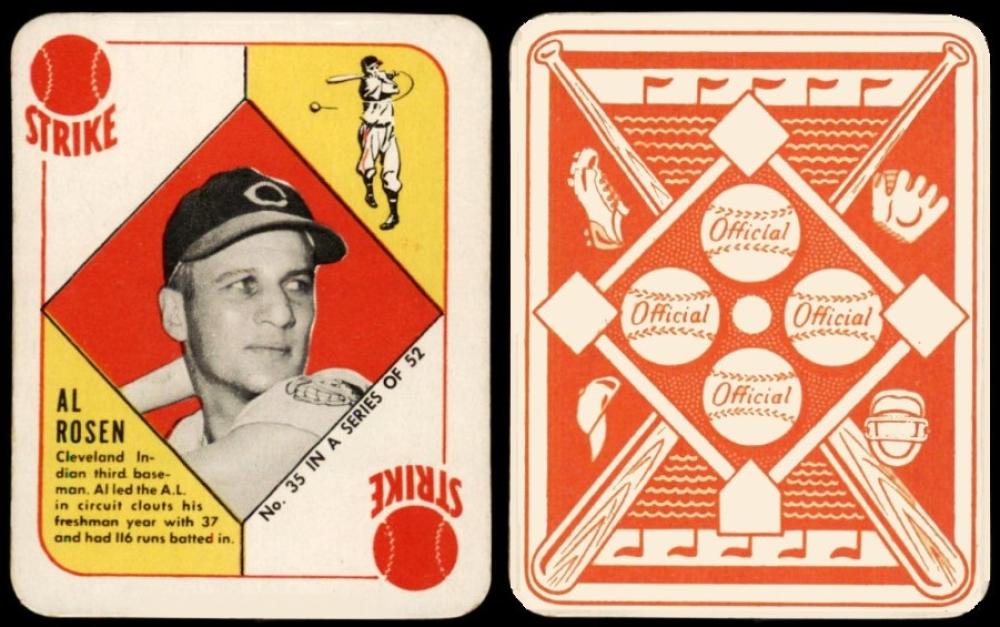
Topps [trade : chewing gum : O/S : USA] “Baseball Playing Cards” (1951) 35/52
Now we have not had a 29th of February for a few years, so happy birthday to all those who make the most of it when they can.
One person with a birthday today, and in 1924 as well, so yet another centenary card, was baseball player Albert Leonard Rosen, usually known as "Al".
In the 1940s and 50s, after four years in the U.S. Navy, out in The Pacific, he played for the Cleveland Indians, and had a short spell as a traded player to the Kansas City Blues - with great results,192 home runs, appearances in the All Stars Game in the mid 1950s for four straight years, and even making the cover of Sports Illustrated. However, he did not make any Major League team until 1947, when he was twenty-three years old.
After leaving the sport, he was a stockbroker, but also remained connected with his beloved baseball. He was the President of the New York Yankees, the Houston Astros, and the San Francisco Giants.
He died in March 2015.
And the Trading Card Database/AlRosen cites him on three hundred and thirty-two cards.
This card is a true trade card, for the wax pack came wih gum. It tells us that you got two cards in every pack for the cost of just one cent. And that the cards were probably designed to be called “Doubles” Baseball Playing Cards”.
We tend to call them “Baseball Series Red Back”, because there is also a set with blue backs. You can read a lot more about it, and better written, at The Cardboard Connection/51Topps
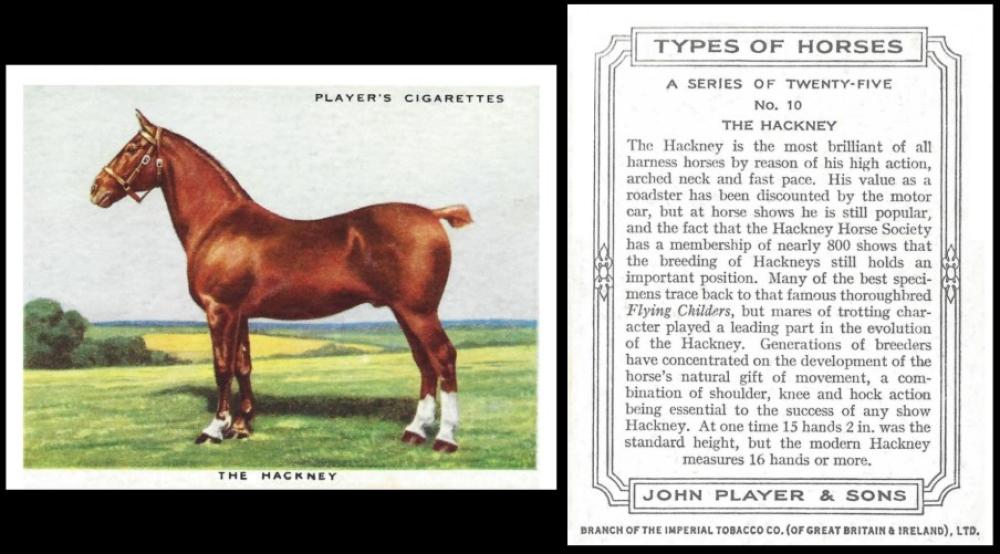
John Player [tobacco : UK] “Types of Horses” - large (February 1939) 10/25 – P644-286 : P72-139 : P/190.A [RB.17/190.A]
And guess what, we close with a centenary card too, for today in 1924 public vehicles were allowed into Hyde Park for the first time since 1636.
Chief amongst these were taxi cabs, which leads us to our fine steed, the Hackney, who provided the original horse-power of the Hackney Cab, which is what the first taxis were called.
Strangely the word is nothing to do with the breed of horse either, it is French, and means a horse for hire. But because that horse was usually attached to a carriage, the word passed into English as the name for the transport as a whole and for the horse when unattached.
The name of horses for general riding for hire was shortened, gradually to hacks. In fact most of the so-called hackney cabs did not use the breed at all, for they are a very specialist one, and unsuitable for use without knowledge and care. The true hackney would only have been used by someone rich who wished to show off, and was willing to pay for someone to drive them about behind one, or a team, of these very distinctive, high stepping, even flashy, and muscular horses, descended from the English Thoroughbred and the Norfolk Trotter.
This set, which I may have used before, is described in our original John Player reference book (RB.17), issued in 1950, as :
190. TYPES OF HORSES. Large cards. Fronts in colour. Backs in grey, with descriptive text. Issued February, 1939.
A. Home issue, with I.T.C. Clause
B. Channel Islands issue, without I.T.C. Clause
Now lets hope the other usage was the other sort!
In our World Tobacco Issues Indexes the description is much shorter, but also more confusing, as the two sets are not together. Our Home issue appears in section 1 as :
TYPES OF HORSES. Lg. Nd. (25). See RB.17/190.A.
whilst the overseas issue is listed under section 3. The listing is identical though, except for the RB.17 code, which now ends “190.B” and the World Index code which is P644-694 in the updated version, or P72-230 in the original
This week's Cards of the Day...
Another week flying by and already it is time to announce the theme of this week, which is #GroundsWeek.
Now I must be honest and admit that though two sites cite it as running from February 20 - 25th others say it is not until March. However as sports and games seem to be returning to our local facilities and parks, it seems as good a time as any to celebrate the often unsung heroes who keep those said sites in perfect working order. And also it must be noted, many of them are either volunteers, or part timers.
Saturday, 17th February 2024

and many thanks to Mr. Price who supplied me with a readable version of the back, rather than my very browned and light one!
We started with week with a stadium, which is where the top groundskeepers aspire to work. This one was White City Stadium, and in the year this card was published, 1908, it was used for the Olympic Games between May and October, which were relocated from Rome due to the eruption of Mount Vesuvius, and the Franco British Exhibition between May and September. Of course the Olympics did not actually take all that time, but the dates are so recorded because the final event, the figure skating, was not held until the October. Mind you that was not even held at White City, but it is still part of the Games.
What you may not know is that it was also at one time the home ground of Queens Park Rangers. This happened twice, in 1931-32 and in 1962-63.
Our World Tobacco Issues Indexes catalogue this set as simply
THE GREAT WHITE CITY. Sm. 68 x 35. Nd. (50)
Sunday, 18th February 2024
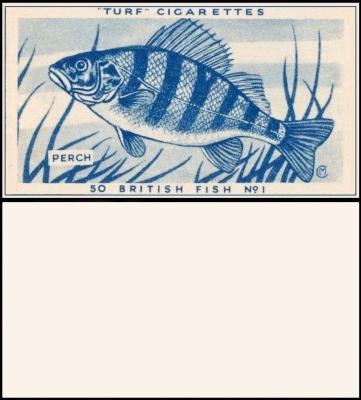
This clue was designed to confuse, as it may show the swimming kind of a Perch, but in ground or land measurement terms a "Perch" measures exactly 5 1/2 yards. It is also known as a rod, and it also measures 16 1/2 feet, or a quarter of a chain, which are useful indeed for measuring land into acres.
People more learned than me regard that the first use of the word "Perch" as a measuring term dates from the Middle Ages, some time between the middle of the thirteenth century and the start of the fourteenth. This was inscribed in a book, written in Latin, called "Compositio Ulnarum et Perticarum", which set down the exact lengths of the measurements of a barleycorn, an inch (the length of three grains of that barleycorn), a foot (as today, twelve inches), a yard (three feet), and a perch (five yards), as well as the exact dimensions of an acre, those being forty perches one way, by four perches the other - a total of a hundred and sixty perches in total.
As far as the fish, they started swimming in the Pleiocene age, way back in the story of creation. They are called perch because their family name is Percidae, or Perciformes, and that refers to the fact that their dorsal fin is subdivided into two, the front part usually having spines and the rear being soft. Again we can thank Carl Linnaeus for the name, at least of the European perch, though he was almost thirty years after the Swedish Petrus Arctaedius (1705-1735), "father of ichthyology" had named the local river fish as a Perch.
This is the home page for all the Carreras "Turf" Slide issues, simply because the first set in alphabetical order and the earliest set to have been issued were both used in newsletters, and that makes finding them just a bit harder.
However, the first thing that we need to say is that "Turf" was used twice by Carreras as a brand, firstly between 1925 and 1937, for sets issued through Alexander Boguslavsky, which fall under Carreras section 2.B of our original World Tobacco Issues Index - and then again for our sets, issued between 1947 and 1956, and these are right at the end of the Carreras, under section 3.B for “Issues 1947 onwards”. That section reads :
HOME ISSUES. Printed on inner slides of `Turf Cigarettes` - one on 10s, two on 20s packings. Front in blue. When cut off, cards are `Turf` brand issues. Listed in order of issue.
- FILM STARS. Nd. (50) Issued 1947 ... C18-101 [in newsletter, on Tue 2 January 2023]
- FILM FAVOURITES. Nd. (50) Issued 1948 ... C18-102
- FOOTBALLERS. Nd. (50) Issued 1948 ... C18-103
- OLYMPICS 1948. Nd. (50) Issued 1948 ... C18-104
- SPORTS SERIES. Nd. (50) Issued 1949 ... C18-105 [in newsletter, on Fri 3 March, 2025]
- FAMOUS FILM STARS. Nd. (50) Issued 1949 ... C18-106 [in newsletter, onTue 23 August 2022]
- FAMOUS CRICKETERS. Nd. (50) Issued 1950 ... C18-107
- RADIO CELEBRITIES. Nd. (50) Issued 1950 ... C18-108
- CELEBRITIES OF BRITISH HISTORY. Nd. (50) As Set C18-37, two numbers changed, see N & N, Vol.6, page 17. Issued 1951 ... C18-109
- FAMOUS FOOTBALLERS. Nd. (50) Issued 1951 ... C18-110
- FAMOUS DOG BREEDS. Nd. (50) Issued 1952 ... C18-111
- BRITISH RAILWAY LOCOMOTIVES. Nd. (50) Issued 1952 ... C18-112
- BRITISH AIRCRAFT. Nd. (50) Issued 1953 ... C18-113 [in newsletter, on Wed 22 January 2025]
- ZOO ANIMALS. Nd. (50) Issued 1954 ... C18-114
- BRITISH FISH. Nd. (50). Descriptive text on attachment, Issued 1954-55 ... C18-115
- FAMOUS BRITISH FLIERS. Nd. (50) Blue and black. Issued 1956 ... C18-116
Our set is indeed the only set with additional wording, but if you trim the card right down, as someone has done to mine, they also trim off the wording. I have now been told that our fish was described, in two lines, as : "A beautiful fish with red fins and "cross bars". Found in most / parts of the country. Two pounders are not uncommon."
Now if anyone has this in the uncut form, a scan would be most appreciated - even more so if it is the double uncut form. Or failing that, just a note of which fish swims beside this one on that double slide. With which in mind here is a list of the pairings on those double slides :
- 5. Bleak - with - 39. Sturgeon
I am not sure how far I will get with this list, so all help is welcome.
Now by the time of the updated World Tobacco Issues Index there had been a bit of a change round, I suspect because it was a bit harder to find the sets in the listing. Therefore they have been relisted in alphabetical order, as :
HOME ISSUES. Printed on inner slides of `Turf Cigarettes` - one on 10s, two on 20s packings. Front in blue. When cut off, cards are `Turf` brand issues. Listed in order of issue.
- BRITISH AIRCRAFT. Nd. (50) Issued 1953 ... C151-620
- BRITISH FISH. Nd. (50). Descriptive text on attachment, Issued 1954-55 ... C151-625
- BRITISH RAILWAY LOCOMOTIVES. Nd. (50) Issued 1952 ... C151-630
- CELEBRITIES OF BRITISH HISTORY. Nd. (50) As Set C151-220, two subjects substituted. Issued 1951 ... C151-635
- FAMOUS BRITISH FLIERS. Nd. (50) Blue and black. Issued 1956 ... C151-640
- FAMOUS CRICKETERS. Nd. (50) Issued 1950 ... C151-645
- FAMOUS DOG BREEDS. Nd. (50) Issued 1952 ... C151-650
- FAMOUS FILM STARS. Nd. (50) Issued 1949 ...C151-655
- FAMOUS FOOTBALLERS. Nd. (50) Issued 1951 ... C151-660
- FILM FAVOURITES. Nd. (50) Issued 1948 ... C151-665
- FILM STARS. Nd. (50) Issued 1947 ... C151-670
- FOOTBALLERS. Nd. (50) Issued 1948 ... C151-675
- OLYMPIC 1948. Nd. (50) Issued 1948 ... C151-680
- RADIO CELEBRITIES. Nd. (50) Issued 1950 ... C151-685
- SPORTS SERIES. Nd. (50) Issued 1949 ... C151-690
- ZOO ANIMALS. Nd. (50) Issued 1954 ... C151-695
Monday, 19th February 2024
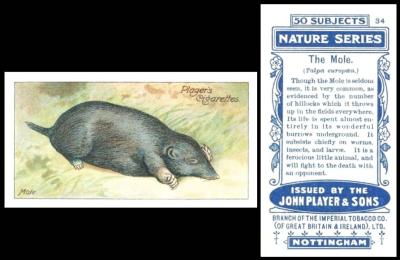
So here we have something that the groundsman is not so pleased to see, Mr. Mole, who comes along and raises his mighty earthworks right slap bang in the middle of the formerly level and green playing surface.
This is a lovely little mole, and a super card. There are also several variations of the set, which I never realised. Our original John Player Reference Book, published in 1950, lists these as :
136. NATURE SERIES. Fronts in colour. Backs in blue, with descriptive text. Home issues.
A. 50 Small cards. Issued March 1909. Some colour varieties seen.
B. 12 Extra Large cards – Birds. Thick board. Issued October 1908.
C. 12 Extra Large cards – Animals. Thinner board. Issued October 1913.
Our World Tobacco Issues Indexes list them, oddly, as :
NATURE SERIES. Nd....P72-41
- A. Small (50)
- B. Extra-large (20) –
(1) Animals Nd. 1/10
(2) Birds. Nd. 1/10
This actually is the right text, there are only ten extra large cards in each set of a very nimble ferret, and that does indeed say it is from a set of ten. So the original John Player book was wrong by saying twelve.
As we have, at last, used a large card as a Card of the Day, on the 13th of March, 2025, the lists of those subjects, and the comparison chart as to where those cards appear in the standard sized set is now removed to there.
Tuesday, 20th February 2024
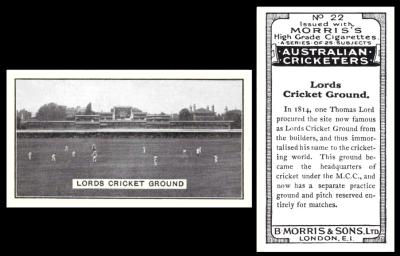
Now the word "ground" has two meanings in cricket.
The obvious one is the field itself, though technically the word applies to the land beneath the seats, and also, especially in Australia, the areas adjoining the stadium, for quite a distance in some cases.
It is also used as a term in play, for there are two grounds on every field, one at each end of the playing area, and they are places where the batter runs to in order to score points. Simply put, they are the site of the wickets. The batter cannot be run out when they are inside of a ground, but once they leave to try and reach the other end, with the aim of scoring more points, they are fair game again.
There are some other more technical points but I am not so sure of them. But if a cricketing expert would like to explain them (in very simple terms) please do
This set has a bit of a secret, because as well as the cricketers which are depicted on cards 1-21 inclusive, it also includes four cards of cricket grounds, these being :
-
22 – Lords Cricket Ground (same title front and back)
-
23 – Melbourne Ground (back says : Melbourne Cricket Ground)
-
24 – Sydney Ground (back says : Sydney Cricket Ground)
-
25 – Old Trafford Ground (same title front and back)
In our World Tobacco Issues Indexes the set is simply catalogued as :
AUSTRALIAN CRICKETERS. Sm. 68 x 37. Black and white. Nd. (25).
Wednesday, 21st February 2024

This set has two versions, as described in our original Churchman reference book (RB.10) published in 1948. This listing reads :
154. JULY 1939. 48. WINGS OVER THE EMPIRE (titled series). Size 2 7/10” x 2 1/10” or 68 x 53 m/m. Numbered 1-48. Fronts printed by letterpress, 4-colour half tone process. Backs in dark green, with descriptions, album clause and I.T.C. Clause Printed by Mardon, Son & Hall.
155. 48. WINGS OVER THE EMPIRE. Identical to item (154), but omitting album and I.T.C. Clauses. Overseas issue
By the way the album and I.T.C. clauses here are along the top and bottom edge, unlike Wills and several other issuers, who chose instead to print theirs along the side edge.
And technically there is a sub-title, of “A Series of 48 Aerial Views”
Now in our World Tobacco Issues Indexes all changes. The home issue appears under section 2.B of the Churchman listings, “Issues with I.T.C. Clause 1922-39", and reads just :
WINGS OVER THE EMPIRE. Md. Nd. (48)
There is no mention of an export issue, but it is there, languishing away under section 3 “Export Issues without I.T.C. Clause”, the header of which tells us that these cards were “Issued 1937-39 through B.A.T. in Channel Islands, Malta and British Garrisons overseas.” However here it does tell us that “All series are similar to the corresponding Home Issue under Section 2.B.” That makes it even odder that there is not an opposite link in section 2.B, which comes first.
Anyway the listing for this Export version is exactly the same as above, with no word as to the differences with the Clauses. It does have new codes though, of C504-790 in the updated W.T.I.I., and C82-99 in the original version
The curious thing for me about this set, given the date of issue and its closeness to the impending Second World War. are some of the subjects chosen. Look at the first three cards, which cover Buckingham Palace, The Houses of Parliament, and St. Pauls Cathedral - mighty targets indeed.
Slightly further on comes card 5, Windsor Castle, where Princesses Elizabeth and Margaret spent the war to keep then away from London.
Then there is card 11, which gives a clear view of Southampton Docks; so vitally important in the First World War that they were known as Military Embarkation Port No.1, thronging with soldiers and supplies, who were encamped in the immediate area. This also occurred in the Second World War, making it quite a target. It was also the home of the Spitfire aeroplane. And indeed almost sixty raids hit the city, the first on the 13th of August 1940. The following month the Supermarine factory was hit for the first time, making it relocate and disperse so that if one was struck the other could keep going.
Thursday, 22nd February 2024
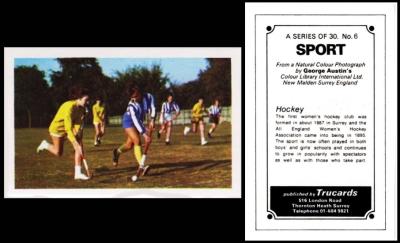
Hockey, or more correctly, field hockey, can be played on a ground, a field or a pitch. The dimensions are 100 yards long x 55 yards wide.
This set, and all the Trucards issues, appear in our British Trade Index volume III, and we have a home page for the issuer with our Card of the Day for the 28th of June, 2023. The full listing of our set reads :
TRUCARDS, Thornton Heath, Surrey.
Cards Issued 1972
- Sport. 69 x 43. Nd. (30) ... TRWM-5
Though these are called Trucards sets, the the first few sets, including ours, which use real photographs actually came from George Austin`s Colour Library International Ltd of New Malden in Surrey. These sets were "Animals", Flowers", our set "Sport". and "Veteran and Vintage Cars" - and they were all issued in 1972. However some of the sets are drawn, and they do not credit this source, though they were also issued in the same year. And I have no idea how they were issued, or what with. Anyone know?
Friday, 23rd February 2024
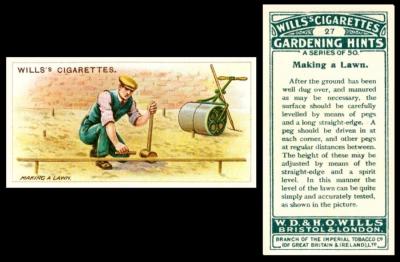
Here we have a super card which is very relevant to the grounds keeper, whose job it once was to repair the turfs that the cleated, hob-nailed boots did tear asunder, and flatten the surface with one of those awfully weighted rollers, with its hard handle that wrought havoc with his fingers and palms.
I cannot believe that this card was issued in the mid 1920s. This is a drawing of the sort of large and stately garden that only flourished until the First World War stole it of its staff and did not return them.
In our original W.D. & H.O. Wills reference book, part III, this set is catalogued as :
227. GARDENING HINTS. Fronts lithographed in colour. Backs in grey with descriptive text. Two grades of board (a) thin, (b) thick. Home issue, 1923. Similar series issued by Imperial Tobacco Co. of Canada.
By the time of the World Tobacco Issues Indexes it is reduced to :
GARDENING HINTS. Sm. Nd. (50). See W/227
By the way do not confuse this with another set by W.D. & H.O. Wills, which is called "Garden Hints". That set was issued in January 1938, and it is much more modern in every way. Though I have to say I much prefer the olde-world charm and gentility of this scene here.
Oh, my apologies to all the early readers - I left you hanging without a word of goodbye. So here it is.
As always thanks for tuning in, and also thanks to everyone who sends in the smallest of contributions. They all make up the patchwork that I weave.
And if you want to contribute anything, the email, as always. is
